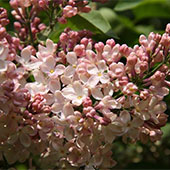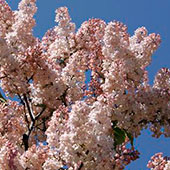Baltet, до 1888
‘Lucie Baltet’, S. vulgaris
Baltet pre 1888; S V
syn. – ‘Louise Baltet’, ‘Lucy Baltet’, ‘Lusi Balte’, ‘Lusie’, ‘Luzie Baltet’; see also ‘Clyde Lucie’, LUSIE (trade designation used for cut flowers of this cultivar)
Carrière, Rev. Hort. 21 [1888]; McKelvey, The Lilac, 328 [1928]; Wister, Lilacs for America, 52 [1942], 34 [1953]; Lilacs – Quart. Jour. 20(4):back cover ill. [1991]; see also: Vrugtman, Lilacs – Quart. Jour. 23(3):75-76 [1994]; Photo on Jorgovani/Lilacs 2015 DVD.
Named for Lucie Baltet Dumont [no dates], daughter of Charles Baltet, France.
cultivar name presumed registered 1953; name established and accepted.
Forcing cultivar in the Netherlands.
Международный регистр названий культиваров рода Syringa L.
Lucie Baltet Carrière in Rev. Hort. 1888, 21, “L’arbuste, d’une vigueur moyenne, est excessivement floribond; sa tenue est bonne et son feuillage très-abondant, courtement pédonculé, est vert un peu blond. Grappe dressée, largement et gracieusement pyramidale, arrondie au sommet, bien fournie sans pour cela être compacte, courtement ramifiée, à ramifications bien garnies. Fleurs très-rapprochées, ordinairement réunies par petits groupes, plus rarement solitaires, assez finement et longuement tubulées, d’un beau rose carminé qui s’accentue un peu avec la floraison, à 4 divisions bien étalées, courtement arrondies, obovales. Odeur fine et agréable sans être trop forte.” — Grosdemange in Rev. Hort. 1893, 286— De Duren in Rev. Hort. Belge Etr. XXI. 157 (1895). — L. Henry in Jardin, VIII. 175 (1894), “Fleur carné pâle ou vieux rose. Coloris délicat, tout à fait rare et remarquable; pas toujours constant. Inflorescences moyennes, variété des plus curieuses et des plus belles.”
Carrière states that this was produced by the Baltet firm of Troyes, France.
Carrière and André (Rev. Hort. 1884, 243) state that in the Baltet nursery they saw upon a plant of this form flowers which were of three different colors, “rose vif, violet rosé” and “gris blanc très légèrement carné.”
Notes on plant in Arnold Arboretum (plant received from T. A. Havemeyer, Glen Head, N. Y., in April, 1917; no. 7627 Arn. Arb.). Flowers single, medium size; corolla-lobes rounded at apex, cucullate; anthers conspicuous; tone pale; color in bud Hellebore Red to Rhodonite Pink (XXXVIII.); when expanded Pale Persian Lilac to Laelia Pink (XXXVIII.) on Ivory Yellow (XXX.). Clusters open, large. This form has flowers which nearly approach a “flesh color”; the plant in the Arnold Arboretum is never a profuse bloomer but is one of the loveliest of the single Lilacs.
“THE LILAC: A Monograph” Susan Delano McKelvey, MacMillan, New York, 1928
No. 2 Lusie Baltet (Baltet). This very goocf, single pink lilac was considered for many years to be the best. It is still considered the best pink lilac by many of those who have not seen the Edw. J. Gardner. Although the florets are small and panicles medium, it is a prolific bloomer. Perhaps it is most beautiful just before the buds open. Shortly after opening, the flowers fade. In hot weather, the fading is very rapid and after a couple of days, in extreme conditions, they may turn to a questionable pinkish white. Under ideal conditions, however, the blooms are very beautiful for several days and they make an excellent cut flower. Growing habits of the plant tend towards the dwarf side.
Edward J. Gardner – Pink Varieties. The Pipeline Vol. III, No. 10, October. 1977
Люси Бальте Lucie Baltet (Baltet, pre 1888)
Бутоны коричневато-красные; цветки светло-розовые, с чуть проступающей голубизной, с нижней стороны темнее, средние (1,5 см), простые, душистые; лепестки округлые, выпукло-вогнутые. Соцветия из одной-трех пар широкопирамидальных, ажурных, ребристых, прочных, прямостоячих метелок средней величины (до 20 х 10 см). Листья овальные, удлиненно-заостренные. Кусты средней высоты. Цветет обильно, продолжительно, хорошо плодоносит. Отличается редкой, оригинальной окраской.
«ВИДЫ И СОРТА СИРЕНИ, КУЛЬТИВИРУЕМЫЕ В СССР» Л.И. Рубцов, Н.Л. Михайлов, В. Г. Жоголева, Киев, Наукова Думка, 1980



Оставить комментарий
Пожалуйста, зарегистрируйтесь, чтобы иметь возможность оставлять комментарии.